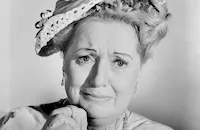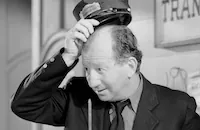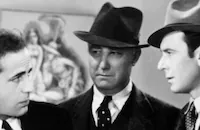The Smiling Ghost

Brief Synopsis
Cast & Crew
Lewis Seiler
Wayne Morris
Brenda Marshall
Alexis Smith
Alan Hale
Lee Patrick
Film Details
Technical Specs

Synopsis
Unemployed engineer Lucky Downing is hired by wealthy Mrs. Bentley to feign an engagement to her granddaughter Elinor Bentley Fairchild. Unknown to Lucky, all of Elinor's former fiancés have suffered horrible accidents. Two of them died as a result and the third, Paul Myron, has been confined to an iron lung for three years. Elinor, who is aware of her grandmother's plan, meets Lucky and his nervous valet Clarence at the station, and Lucky is delighted to discover that she is very beautiful. Her relatives are a different matter: Sinister great-uncle Ames Bentley has a collection of shrunken heads; cousin Tennant Bentley has a drinking problem; and Uncle Hilton Fairchild and his wife Rose will lose part of their fortune when Elinor marries. That night, as Lucky prepares for bed, Tennant objects to his presence in what had been Tennant's room. Lucky agrees to switch rooms with Tennant, and later, Tennant is attacked by a man who resembles Elinor's first fiancé, John Eggleston. In the confusion, Lucky meets reporter Lil Barstow, who has been writing about Elinor's romantic troubles for the local newspaper. Lil tells Lucky the truth about his predecessors and persuades him to leave. He changes his mind and stays, however, when Elinor confesses that she has fallen in love with him. When Lucky tries to stop Lil from writing the story of his broken engagement, she takes him to visit Paul, who expresses his belief that Eggleston is not really dead and is killing Elinor's fiancés out of jealousy. Lil and Lucky head for the cemetery to make sure that Eggleston is really in his grave, and Lucky is attacked and shut in Eggleston's coffin. After Lil rescues him, Lucky suggests that he and Elinor pretend to marry in order to lure the killer out of hiding. She coaxes him to make it a real ceremony, to Lil's dismay. Lil is sent to cover the wedding, and while writing in the library, is startled by a man who appears through a secret panel. Her screams bring Lucky rushing to her aid, but she has disappeared when he arrives. Norton, a policeman masquerading as a butler, locks Lucky and Clarence in the same room, believing that they will be safe there. By accident, they discover the secret panel and find the missing Lil. Lucky is attacked by the killer, but fends him off and reveals that he is Paul disguised by a mask that makes him look like Eggleston. Paul pretended to be confined to an iron mask and killed the others out of revenge when Elinor refused to marry a cripple. With the mystery solved, Lucky confesses that he has fallen in love with Lil and will marry her rather than Elinor.

Director
Lewis Seiler
Cast

Wayne Morris

Brenda Marshall

Alexis Smith

Alan Hale

Lee Patrick
David Bruce

Helen Westley

Willie Best

Charles Halton

Richard Ainley
Roland Drew

Clem Bevans
Arthur Aylesworth
Vera Lewis
Tom Dugan

Hank Mann
Creighton Hale

Jack Mower
Joan Winfield
Al Lloyd
Frank Hagney
Renie Riano
Chester Clute
Frank Mayo
Cliff Saum
Crew
Wilbur M. Beatty
Hugh Cummings
Bryan Foy
Kenneth Gamet
Edmund Grainger
Stanley Jones
Jack Killifer
Art Lueker
Ben Markson
Stuart Palmer
Stuart Palmer
Hugh Reticker
Leah Rhodes
Ralph Spence
Arthur Todd
Perc Westmore

Film Details
Technical Specs

Articles
The Smiling Ghost

The Smiling Ghost
Quotes
Trivia
Notes
Although director Lewis Seiler receives screen credit, a May 21, 1941 Hollywood Reporter news item notes that A. Edward Sutherland replaced him, pushing back the start of the film. A second news item dated May 22, 1941 contradicts this, however, and states that Sutherland was assigned to another film, Nine Lives Are Not Enough, which he did direct. According to a pre-production press release included in the file on the film at the AMPAS Library, the film was based on a mystery story by Philip Wylie and B. A. Bergman. The SAB does not credit them, however, and the extent of their contribution to the completed film, if any, has not been determined.















